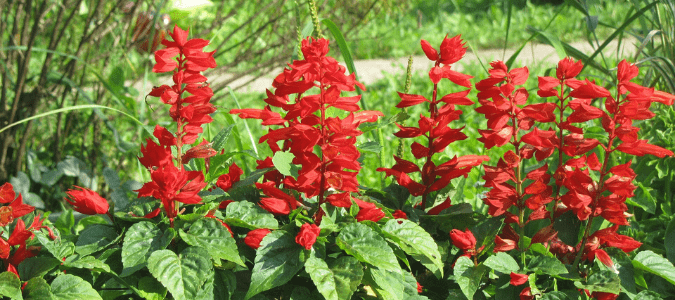
Salvias are popular ornamental plants that provide a pop of color in your yard and can withstand extreme temperatures. There are over nine hundred different species of salvias, each with different flowers and smells. Salvias thrive in warm climates and don’t need much water, making them a relatively low maintenance plant in Texas and other southern states. Pruning salvias can enhance their appearance and help these plants stay healthy throughout the year. There are three main categories of salvias, and each should be pruned slightly differently.
Deciduous Herbaceous Salvias
Deciduous herbaceous salvias are shrub-like and have soft stems. These salvias include:
- Pineapple sage, also known as tangerine sage
- Mexican Bush sage
- Waverly sage
- Bog sage
- Gentian sage
These types of sage are relatively easy to prune. In the winter, older, soft stems will die off or freeze, so you’ll want to wait until the spring to do your pruning. Any old growth that is left on the plant will actually protect new blooms as they start to develop. After the last frost of the season, simply cut the stems all the way down to the base. This type of salvia grows quickly, so you won’t need to worry about the stumps in your yard for long. Depending on how quickly your salvias are growing, you’ll only need to prune once or twice a year.
Although pruning isn’t necessary for this type of salvia, many homeowners notice that stems can become a matted, unappealing mess if they choose not to prune. In addition, the thicker the undergrowth, the less likely the roots will get the sunlight that they need.
Herbaceous Salvias With Woody Stems
Herbaceous salvias with woody stems are very similar to deciduous herbaceous salvias. The main difference is that these plants have tougher, stronger stems, as the name suggests. Some examples of these types of salvia include:
- Autumn sage
- Germander sage
- Scarlet sage, also known as blood sage, Texas sage or tropical sage
- Baby sage
Similar to their deciduous counterparts, these salvias benefit from pruning after the last frost of the season. However, you don’t need to prune these plants all the way down to the base. If you do, the plant may not grow back. Just prune these sages down to where the very last flower is located.
During the spring and summer months, prune these salvias as needed to improve their appearance and remove any dead branches. In the summer, prune the stems down to the leaf clusters to prevent overgrowth. Without proper pruning, these salvias can look very woody and messy, so while skipping your pruning won’t be the end of the world, your plants won’t look great.
Rosette Forming Herbaceous Salvias
This type of salvia is known for blooming beautiful rosettes. Salvias that are included in this category include:
- Hummingbird sage
- Woodland sage
- May night sage
- Big red sage
As this salvia grows throughout the summer, you’ll want to keep a lookout for any flowers that are starting to fade so you can deadhead them. Deadheading simply means pinching or trimming off blooms as they begin to fade or turn a dull green or brown color. By staying on top of deadheading, the salvia may bloom a second time or even a third time.
When your salvia stops producing new blooms, which may be in late summer or early fall, you’ll want to cut the salvia down to the ground. Just keep in mind that if temperatures are going to drop below twenty degrees in the winter, you’ll need to protect your salvias by spreading an organic compost followed by an organic mulch around the areas where they bloom.
There’s more to caring for salvias than just pruning. Now, we’ll review other important tips about growing salvias, including what types could work best for your property.
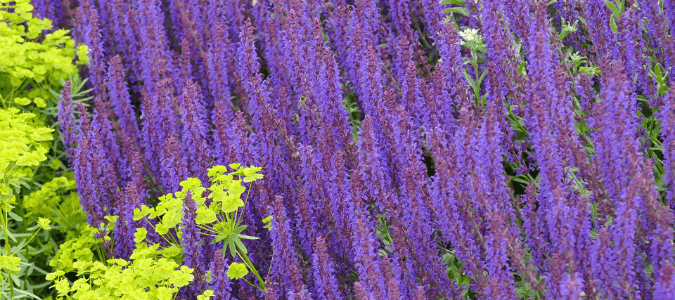
Beyond Pruning: How To Care For Salvias
The primary reasons salvias are so popular among gardeners is because they are beautiful, they attract pollinators and, once established, they are drought-tolerant and generally low-maintenance. While there are plenty of benefits of pruning, there are a few additional tasks that you must stay on top of them to keep these plants looking fantastic and staying healthy. The basics of how to care for salvias involve knowing when and where to plant them, what to feed them and how to deal with “salvia flop”.
When To Plant Your Salvias
Salvia seedlings should be purchased right before spring. For best results, keep these plants inside for the beginning growth stages. Go ahead and plant your seeds in a pot inside your home six to eight weeks before the last expected frost of the season. Once the threat of frost has passed, move your plant outdoors. If you decide to purchase a sprouted salvia from a home improvement store, you may want to hold off on your purchase until after the last frost in your area.
Where To Plant Your Salvias
Because these plants don’t need particularly rich soil, you can plant them nearly anywhere that gets consistent sun exposure and good drainage. A few varieties can even thrive in shade. A few ways you may want to consider adding salvias to your landscape include:
- Lining your foundation with salvias. If properly built, the space around the foundation of your home will already have great drainage. Because of this, it’s a natural fit for cultivating salvias.
- Softening edges along garden pathways. Salvias always do well along walking paths because they typically get enough sun there, and tend to bend and spill over, creating natural path edges.
- Adding salvias to containers for added drama. The right salvias in the right containers can provide quite a dramatic effect on your outdoor entryways and entertainment areas.
Wherever they wind up, salvias need breathing room. The exact space depends on the species, but you’ll need to position these plants based on the expected size at maturity. Not only do salvias need room for their roots, but they also require good air circulation, too.
If you are unsure about where you would like to plant your salvias, or if you want to make sure you’ll have enough drainage and sunlight for your salvias to grow properly, you can always contact a landscaping professional who understands the conditions under which these plants do best. A landscaper will usually be able to help with other yard problems as well, such as determining what is causing your St. Augustine grass problems.
Feeding Your Salvias
If you are planting new salvias, apply a balanced organic fertilizer into your soil before planting. Afterward, a light application of fertilizer or compost come spring is really all salvia plants need. That being said, while nearly all salvias are drought-resistant after getting established, watering occasionally will improve their appearance and help them in hot and dry weather.
If you have salvias in containers, add some fertilizer every couple of weeks, or as your plants are starting to look dry. Never let your salvias dry out completely.
Dealing With “Salvia Flop”
Many homeowners aren’t sure what caused their salvias to become floppy. Sometimes, the cause of salvia flop is too much fertilizer or not enough sun, but the usual culprit is poor drainage. Try adding wood chip mulch or rough-edged rocks to the area in which you are planting. This will protect salvia roots from becoming waterlogged. If flopping does occur, you can support your plants by adding stakes next to the stems that are bending over. Or, simply deadhead the flowers and allow new, stronger blooms to grow in.
While salvias are relatively easy to grow and maintain, some homeowners prefer to enlist a landscaping professional to take a closer look at their yard and make customized recommendations on the best varieties of salvia for their landscape. These experts can also provide ongoing maintenance for your lawn, so it’s one less thing you need to worry about throughout the year.
Here in Texas, there are a few different types of salvias that do particularly well in residential areas.
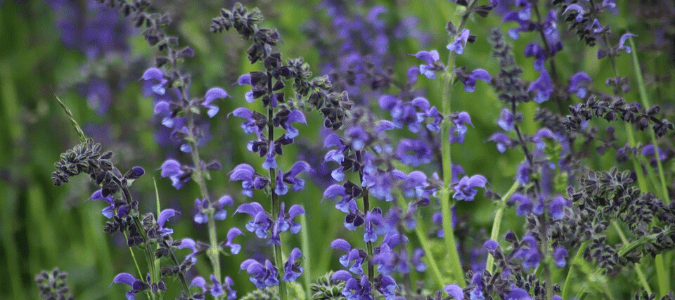
What Are the Different Types of Texas Salvias You Should Know About?
With the warm climate in Texas, salvias do quite well. While there are many different varieties that grow in the South, the most popular Texas salvias include:
- Mealy-Cup or Blue sage (Salvia farinacea). This sage is native to South and Central Texas and grows to be about three feet tall with spikes of blue flowers that bloom throughout the summer.
- Autumn sage (Salvia greggii). This type is partially evergreen and somewhat woody, grows to be about three feet tall and, depending on the seedlings you pick up, will develop red, white, pink, rose, purple or orange flowers.
- Indigo Spires. This hybrid has the appearance of a large, round bush and is known for its deep blue flowers.
- Mexican Bush sage (Salvia leucantha). This plant only blooms in the fall, and when it does, you’ll see long, rosy-purple spikes that develop tiny white flowers.
- Texas sage (S. coccinea). This Sage grows to be between two and three feet tall, and while it is most commonly red, there are also pink and white selections available.
- Brazilian Sage or Anise sage (S. guaranitica). This plant has beautiful, dark blue tubular flowers that bloom from summer through the fall.
- Pineapple sage (S. elegans). This variety develops long, red flowers. You can use its leaves to add fragrance and flair to salads, drinks and potpourri.
- Scarlet sage (S. splendens). This type of salvia actually does well with some shade and is available in a variety of different colors, including scarlet red, pink, purple and white.
We’ve only just touched on a few of the varieties of salvia available to you here in Texas that are easy to find and can withstand our hot and dry weather.
If you’re searching for a salvia that will bloom all year long, you may want to choose an annual.
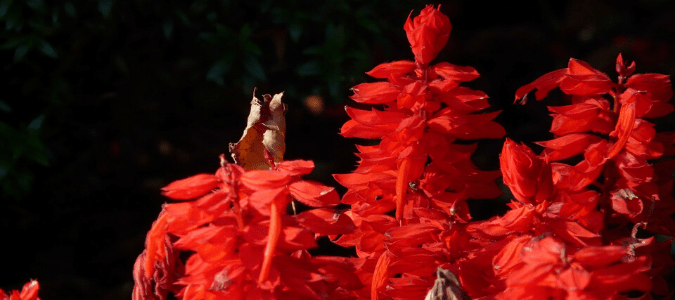
Types Of Annual Salvias
Many people choose annual salvias for their outdoor spaces because these plants stay beautiful all year round. Annual salvias grow anywhere from one to two feet tall and are available in blue, red, pink, orange or white varieties. These plants are also wonderful for attracting butterflies and hummingbirds while being deer resistant.
Some common annual salvias include:
- Red salvia
- Victoria Blue salvia
- Summer Jewel Pink salvia
- Clary sage
- Mystic Spires Blue salvia
- Coral Nymph salvia
Taking care of these plants is relatively simple. You’ll probably want to apply a liquid fertilizer monthly, keep the soil moist and plant seedlings in areas with good drainage. Although most varieties of salvias do best in full sun, some types can be planted in shady areas.
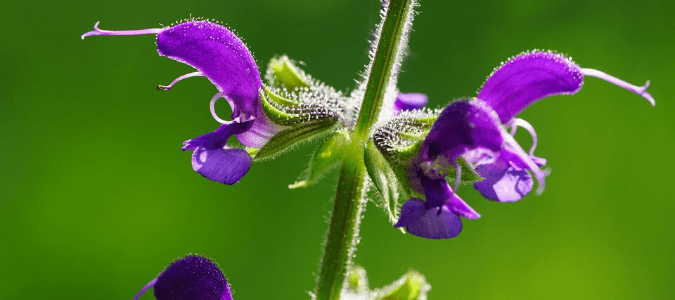
Salvias For Shade
While salvias, in general, tend to need a good amount of sun, there are some types that do well in shaded spots. Before you get started, make sure you think about your yard and which salvias do well under different amounts of sun exposure.
Full Shade
Also called deep shade, these areas rarely see any sun. If you have dense tree cover, you may need a sage that’s suited to full shade. In these situations, you can try Arizona Blue sage, Chinese sage and Temascaltepec sage.
Partial Shade
Under leafy trees, near the edge of wooded areas and next to shaded structures (for example, shade sails and covered pergolas) are considered partial shade. These spots may see only dappled sunlight. Fruit Scented sage, Chiapas sage and Wendy’s Wish sage grow well under these conditions.
Morning Sun And Afternoon Shade
Some varieties of salvia are quite fine with sunlight in the morning and shade later in the day. Giant Bolivian sage, Blue Vine sage and Buchanan’s sage fall into this category.
If you know where to plant salvias, what to feed them and how often to prune them, your plants should be in good shape. However, every yard is different, so to get best results, reach out to a landscaping professional if you are considering adding salvias to your yard.
ABC Can Plan And Maintain Your Landscape
You can take the guesswork out of caring for your salvias and any other plants by bringing in the landscape professionals from ABC. Our experts can give you guidance on how to best integrate these plants with your existing landscaping. After your plants have become established, our lawn care specialists can take over ongoing maintenance so it’s one less thing you have to worry about.
